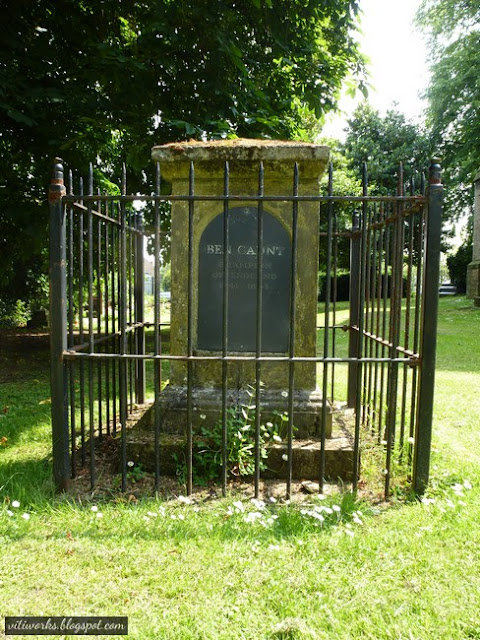The tower of St. Mary Magdalene was built in stages between the 1100s and 1300s, although much of the building is Victorian restoration and enlargement.
The church is the burial place of Lord Byron, his daughter Ada Lovelace (who assisted Charles Babbage in pioneering development of the modern computer programmes). Ben Caunt, an English prize fighting bare knuckle boxer, is also buried in the churchyard.
This Armenian stone cross (Khachkar) on the outside wall of the church was sent as thank for the help after the big earthquake in Armenia in 1988.
On the left hand side of the church is the library. It was built in 1886 and was a gift to the town by two partners of the Hucknall Colliery Company. There was a games room, a reading room and silence was strictly observed.
On the right hand side, on the other side of the market, is the Co-op Building. This building was once a flourishing departement store. In 1898 the Hucknall Torkard Industrial Provident Society Central Stores were open for buisness. They provided a grocery store, drapery and millinary departements, tailoring departements, general offices and boardroom plus the Co-operative Hall.
Placed in a niche on the wall of the Co-op Building is a statue of Lord Byron, made by Elias Lacey.
The Coffee Tavern was built as part of the Victorian Temperance campaign as an alternative to public houses.
The Public Hall was built in 1875. It cost 2000 Pound and could seat 550 people. It was often used for public entertainment such as plays, pantomimes or magic lantern shows.
Colliery Houses in Watnall Road. This place was called Deputies Row as the houses were built by the Hucknall Colliery Company for strategic workers. Each house had a cellar and a tap was placed in front of each house for drawing water from wells.
Baptist church in Watnall Road. The Memorial Stones for this church were laid on 29th May 1876. It was to be constructed to provide accomodation for 700 people, 360 on the ground floor, 340 in the gallery. The church was finished and opened in April 1877.
Beardall Street School. This building was the first Board School in Nottinghamshire, if not the first in the country. It housed three schools, boys, girls, and infants. A report dated 2nd January 1873 said the school was opened.
Watnall Road Community Center was originally St. Peter´s Church, built in 1892.
The Memorial stone of Zachariah Green stands in Tichfield Park. Zachariah Green was a healer and the locals thought so highly of him that they organised to erect this memorial stone in his honour.
Tichfield Park was a beauty spot until WW2. Buses came from all over the place, bringing thousands of people to see the pleasure grounds, boating lake, childrens´s amusement, sand pit and paddling pool.
The Red Lion Pub is an example of an 18th century hostelry. It was the rent house of the Byron family and had a row of cottages in the rear yard.
After all these more or less historical stuff I needed some nature and went for a walk in the valley of the River Leen.
All Informations about Hucknall was taken out of the leaflet "Walk & Talk - The Heritage of Hucknall". Thanks!






























I like your birds and flowers most. The peacook particularly
ReplyDeletehttp://www.watsonfothergill.co.uk/building.htm The imposing structure with the "To Let" sign on it was was built by the famous architect Watson Fothergill,it must be worth millions.
ReplyDeleteThat was a nice find :) Thank you for adding the link, Bluebottle!
DeleteDon´t go visiting Hucknall - it´s dangerous :P
ReplyDeletehttp://www.bbc.com/news/uk-england-nottinghamshire-26566043